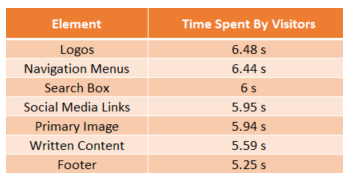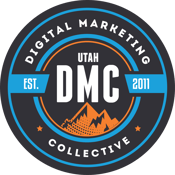Bradley Friedman - 7 Hacks To Improve Your Web Conversions
Bradley Friedman from Lucky Orange kicked off this evening’s SLC SEM event with a presentation on CRO. What is CRO you might ask? CRO stands for Conversion Rate Optimization, which refers the practice of increasing the percentage of visitors on a website that convert into customers, or more generally, take any desired action on a website.
Bradley dives into his presentation with 7 hacks or tips to help improve your website’s conversions.
1. 1st Impressions Always Matter - What a user sees when they land on your website matters significantly from aesthetics to bounce rates. Make sure your website has a simple design, a clear Call To Action (CTA) and features real customers when applicable.
In addition, Bradley shares with the audience some helpful averages for time spent on site by users on various elements:

It’s also important to remember that bounce rates can vary depending on the type of website.
2. Be Our Guest - Hack number 2 references ‘Be Our Guest’, think of Beauty and the Beast. In the movie during this scene, guests are wined and dined and having a great time. Your website should mimic this feel and should be comfortable. A positive user experience is crucial for conversions, so you want your website to be easy to navigate and very pleasing.
3. The Right Feedback Matters - Being able to receive the right feedback and gives users access to communicate can also be a very powerful tip. Consider using chat services so that you can interact with visitors, or utilize polls or surveys.
4. It’s You, Not Me - Analyze your landing page, are there any errors? Consider using form analytics to determine how users are interacting with your form fill. You may be able to diagnose if a user is not submitting the form due to a phone number format error.
5. Know Your Audience - Create buyer personas so that you can fully understand your targeted demographic. Once you understand your ideal customers, it will be easier to tailor your landing page to them.
6. Use The Right Tools - There are many tools that you can utilize to assess your website's performance and optimize for conversions, such as all-in-one tools or one-offs that may have a specific desired feature for you. Here are some of the features tools can offer that you should be utilizing for your websites CRO:
- Dynamic Heatmaps
- User Recordings
- Interactive Polls
- Live Chat
- Conversion Funnels
- Form Analytics
- Email Reports
- Dashboards
7. Collaborate Across Teams - Share your CRO findings across teams so that your strategy and messaging is consistent.
Madison Hajeb - How To Fail at A/B Testing
Our next speaker, Madison Hajeb shares with us her laundry list of how to fail at a/n testing. Mistakes can happen at all stages throughout the testing process, whether it’s pre-test, mid-test or post-test. Knowing these mistakes may help you steer clear of them in the future.
Pre A/B Test
Madison shares with the audience the importance of doing your research before testing. She recommends performing qualitative and quantitative research. Ask yourself the following questions before testing - Is it easier to be clicked and what was clicked on the most? In addition to research, make sure that you are setting the appropriate test duration based on the amount of traffic volumes, baseline data and significance. In order to have statistically significant data to pull your assessment from you must set the appropriate test duration to acquire the right amount of information needed. Also, be careful to not set up too many test variations so that your tests are still impactful and make sure to check the website update schedule. Nothing can ruin your test faster than throwing in new variables.
Mid A/B Test
During your a/b tests, make sure that you are measuring the correct KPI’s. Do form fills or phone calls make the most sense for your test? Also, make sure that you do not drive new traffic sources during your test. Running a new promotion or campaign can significantly skew your test data and accuracy, this also goes for changing the website URL. And most importantly, never turn off the test early!
Post Test
Next Madison shares with us common mistakes that can happen once you complete your a/b testing. Once you complete your test, never neglect the why. Don’t ignore temporal functions. Make sure to implement positive results and never assume something works for everyone. Just because you have positive results from one test, don’t assume that this can be applied across all segments. And most importantly, the biggest mistake that you can make however, is to not a/b test at all.
Chris Dayley - Conversion Optimization
Our final speaker of this evening’s event was Chris Dayley from Disruptive Advertising. Chris shares with us his Launch Analysis which shows the 6 primary factors that they look for when a/b testing, pictured below.
Chris then takes a deeper dive into what each of this components mean, what to look for and what to ask yourself.
- Value Proposition - This is essentially what you offer, why people care and what the value is that your audience is getting from you. The idea here is to make sure that the perceived value outweighs the perceived cost.
- Call To Action - This is telling the consumer what to do, such as ‘download now’ or ‘click here’. Chris tells us to follow the 2 second rule, meaning within 2 seconds of going to the page, the CTA should be clear. He also recommends color contrasting CTA buttons and testing different verbiage or text variations.
- Content - Is the content relevant, clear, readable and concise? Here you want people to understand the value. Ask yourself, is there anything that we could say in a different way?
- Diversions - For this component, ask yourself, Is there anything that could be distracting from the CTA? Chris suggests making a list of anything that could be potentially distracting and a/b test. These could be items such as contrasting buttons, images, offers, menus, links, pop-ups, etc.
- Anxiety - Is there anything on the landing page that is unclear, confusing, alarming, frustrating, etc? Eliminate anything that creates too much effort to complete the CTA. For this, go through the page as if you were a user and ask yourself what might be frustrating? If you have to go to the menu to find your CTA, you are doing it wrong.
- Responsiveness - For this step, you want to assess how customized to mobile is your design. Being mobile responsive doesn’t always mean your website is designed for a mobile user or the mobile experience.
To learn more about the next SLC SEM Conference, be sure to visit our events page.
